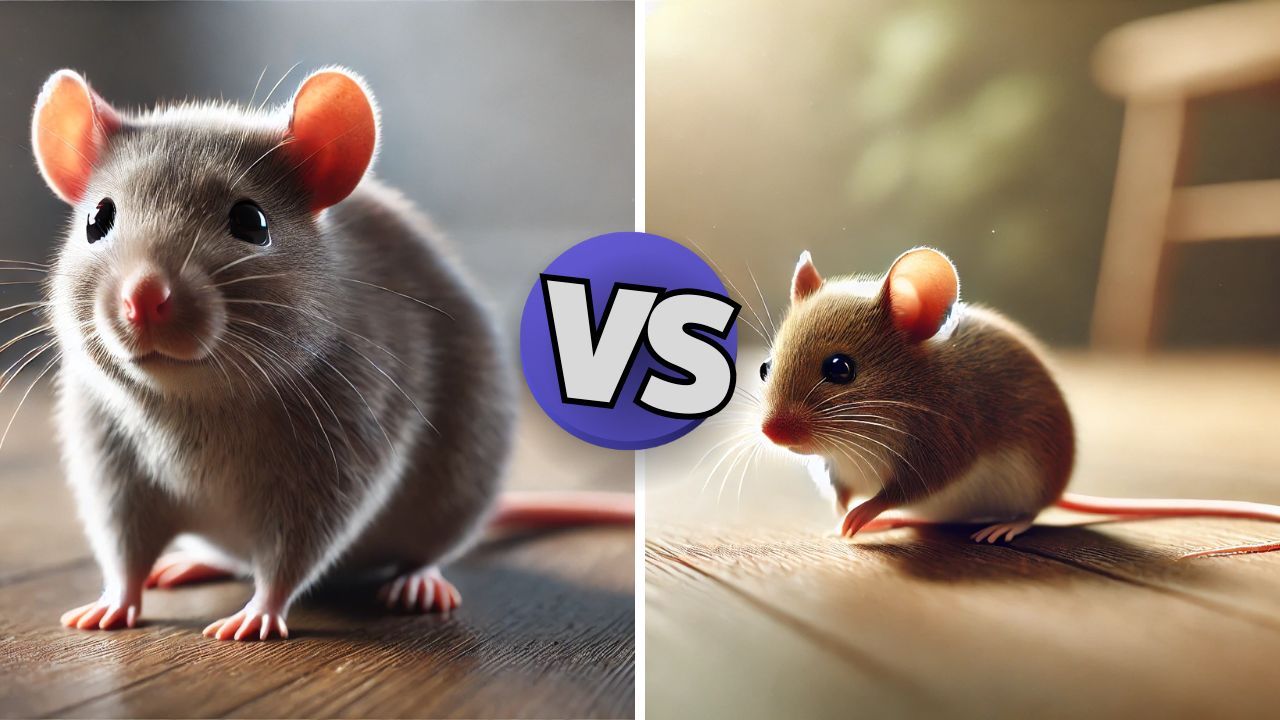Key Takeaways
-
Physical Differences: Rats are larger with blunt noses and thick, hairless tails; mice are smaller with pointed noses, large ears, and thin, hairy tails.
-
Behavioral Traits: Rats are cautious and trap-shy, while mice are curious and easier to catch.
-
Dietary Preferences: Rats eat almost anything, including meat and garbage; mice prefer grains and plant-based foods.
-
Signs of Infestation: Rat droppings are large and blunt; mouse droppings are small and pointed. Rats cause significant structural damage; mice nibble on packaging and small items.
-
Health Risks: Both rats and mice spread diseases like hantavirus, leptospirosis, and salmonella.
-
Prevention Tips: Seal all entry points, inspect for signs of activity, and use natural repellents like peppermint oil or ammonia.
-
Seasonal Awareness: Rodents move indoors during cooler months—be especially vigilant in fall and winter.
-
Control Measures: Use traps and baits in high-activity areas; consider pets like cats as natural deterrents. Contact pest professionals for accurate identification and effective treatment.
 Ever heard unsettling noises late at night and wondered, “Is it a rat or a mouse?” You’re definitely not alone. You’re definitely not alone. Honestly, figuring out exactly what kind of critter has invaded your home can be tough. But knowing the difference can save you tons of stress—not to mention protect your home and family’s health. Let me explain why spotting these differences matters so much.
Rats and mice are two of the most common rodent pests, but they differ significantly in size, behavior, and the risks they pose to homes and health. Recognizing the differences between rats and mice is essential for effective pest management and prevention.
This article will explain how to identify rats and mice, highlight their unique traits, and provide actionable tips for control.
If you’re unsure what’s lurking in your home, our experts offer a free pest inspection to help you quickly pinpoint and tackle the problem. Schedule your risk-free visit today!
Ever heard unsettling noises late at night and wondered, “Is it a rat or a mouse?” You’re definitely not alone. You’re definitely not alone. Honestly, figuring out exactly what kind of critter has invaded your home can be tough. But knowing the difference can save you tons of stress—not to mention protect your home and family’s health. Let me explain why spotting these differences matters so much.
Rats and mice are two of the most common rodent pests, but they differ significantly in size, behavior, and the risks they pose to homes and health. Recognizing the differences between rats and mice is essential for effective pest management and prevention.
This article will explain how to identify rats and mice, highlight their unique traits, and provide actionable tips for control.
If you’re unsure what’s lurking in your home, our experts offer a free pest inspection to help you quickly pinpoint and tackle the problem. Schedule your risk-free visit today!


Not getting a solution?
Get your free pest control estimate today!Difference between their Size
Here’s the deal: size is your first clue. You don’t even need a measuring tape—a quick glance usually tells you everything.- Rats: Pretty hefty pests, typically around 7–10 inches long, excluding their tails, and weighing about half a pound. Imagine a bulky, muscular intruder scurrying around your home.
- Mice: Tiny by comparison—just about 3–4 inches and under an ounce. Honestly, mice are so small they squeeze through openings the size of a dime.

How to Identify Rats and Mice
Correctly identifying whether you are dealing with rats or mice is crucial for implementing effective pest control measures. It is because when it comes to rodents, appearances matter big time.Identifying Rats
-
 Size and Weight: Rats are larger, measuring 7–9 inches in body length (excluding the tail) and weighing 300–500 grams.
Size and Weight: Rats are larger, measuring 7–9 inches in body length (excluding the tail) and weighing 300–500 grams. -
 Appearance: They have sturdy, blunter snouts, stocky bodies smaller ears that look a bit small to their body size, and thick, hairless tails which are shorter than their bodies.
Appearance: They have sturdy, blunter snouts, stocky bodies smaller ears that look a bit small to their body size, and thick, hairless tails which are shorter than their bodies. -
 Behavior: Rats are cautious and suspiciously inspect new traps for days before going near them. They tend to avoid new objects in their environment, making them more challenging to trap. They prefer hiding down low—in basements, garages, or burrows, making them annoyingly tricky to catch.
Behavior: Rats are cautious and suspiciously inspect new traps for days before going near them. They tend to avoid new objects in their environment, making them more challenging to trap. They prefer hiding down low—in basements, garages, or burrows, making them annoyingly tricky to catch. -
 Common Species: Norway rats and roof rats are the most frequently encountered species.
Common Species: Norway rats and roof rats are the most frequently encountered species.
Identifying Mice
-
 Size and Weight: Mice are smaller, about 2–4 inches in body length, and weigh 12–30 grams.
Size and Weight: Mice are smaller, about 2–4 inches in body length, and weigh 12–30 grams. -
 Appearance: Mice have triangular/sharp noses, large ears that stand out, and long, thin, hairy tails longer than their little bodies. They’re almost cute—until you find them rummaging through your snacks.
Appearance: Mice have triangular/sharp noses, large ears that stand out, and long, thin, hairy tails longer than their little bodies. They’re almost cute—until you find them rummaging through your snacks. -
 Behavior: Mice are incredibly curious and always actively explore new environments and they get into things they shouldn’t, making them easier to catch. Because they’re bold explorers, they’re usually easy to trap.
Behavior: Mice are incredibly curious and always actively explore new environments and they get into things they shouldn’t, making them easier to catch. Because they’re bold explorers, they’re usually easy to trap. -
 Common Species: The house mouse is the most common type found in homes.
Common Species: The house mouse is the most common type found in homes.
 What do Rodents Species Eat ?
Both rodents are foodies, but their eating habits differ significantly:
What do Rodents Species Eat ?
Both rodents are foodies, but their eating habits differ significantly:
- Mice: Grains and cereals are their favorites. They nibble small amounts frequently, leaving behind tiny chew marks. Who’s been munching on your cereal? Probably mice.
- Rats: Far less picky, they’ll eat anything from leftover pizza to pet food. Rats’ teeth are so strong they can gnaw through plastic, wires, wood, and even metal. Finding your cereal box shredded open is a classic rat move.
Droppings and Other Detective Work
When hunting for clues, droppings are your best evidence:- Rats: Droppings are larger (3/4 inch), blunt, and dark. Think raisins—but definitely less appealing.
- Mice: Smaller droppings (1/4 inch), pointed at the ends, and look like tiny black rice grains.
- Rats: Bigger, noticeable gnaw marks and distinct footprints.
- Mice: Smaller scratches and footprints that are harder to notice.

Seasonal Surprises: When Rodents Move In
Rodents typically seek shelter during cooler months. As temperatures drop, both rats and mice might see your cozy home as the perfect winter getaway. Staying vigilant during fall and winter helps prevent unexpected invasions. You know what? Even warmer seasons aren’t entirely safe—rodents will look for easy food sources year-round.Lifespan Difference Between Rats and Mice
- Understanding lifespan differences between rats and mice can greatly influence your pest management strategy. Here’s a quick breakdown:
-
Pet Rats: Live 2–3 years on average, and can reach up to 4 years with excellent care.
-
Pet Mice: Have a shorter lifespan, typically ranging from 1.5 to 2 years.
-
Wild Rats: Survive 1–2 years in the wild due to predators, disease, and environmental stress.
-
Wild Mice: Often live less than 1 year under harsh outdoor conditions.
-
Influencing Factors: Diet, living conditions, and access to veterinary care significantly impact overall lifespan.
Common Entry Points: Where They Sneak In
Wondering how rodents enter your home? Honestly, you’d be surprised. Both rats and mice can squeeze through surprisingly small gaps:- Cracks in walls and foundations.
- Openings around pipes and wires.
- Gaps around windows and doors.
- Roof vents and chimneys (especially roof rats).
Rats Vs Mice: Key Differences
While both are rodents, rats and mice have notable differences in appearance, behavior, and preferences.| Feature | Rats | Mice |
|---|---|---|
| Size | Larger and heavier-7-10 inches | Smaller and lighter-304 inches |
| Weight | 0.5 pounds | Less than 1 ounce |
| Snout | Blunt | Pointed |
| Ears | Small relative to body size | Large relative to body size |
| Tail | Thick, hairless, and scaly | Thin, long, and hairy |
| Behavior | Cautious and avoid unfamiliar objects | Curious and exploratory |
| Preferred Diet | Varied, including meats and garbage | Grains, seeds, and plants |

Signs of Rats and Mice Infestation
Identifying signs of infestation early can prevent significant damage and health risks.Signs of Rat Infestation
- Droppings: Larger droppings, about 3/4 inch long, with blunt ends.
- Gnaw Marks: Bigger gnaw marks on wood, wires, and packaging.
- Nesting Sites: Found in burrows, basements, or attics.
- Tracks and Smears: Greasy marks along walls or floors from their fur.
Signs of Mouse Infestation
- Droppings: Small, about 1/4 inch long, with pointed ends.
- Gnaw Marks: Smaller gnaw marks on food containers and furniture.
- Nesting Sites: Built from shredded paper or fabric, often near food sources.
- Noises: Light scratching or scurrying sounds in walls or ceilings at night.

Methods to Prevent and Control Rodents
Implementing proactive measures can help prevent and manage rat and mouse infestations effectively.Rodent Prevention Tips
-
Remove outdoor debris like woodpiles and garbage.
-
Screen vents and chimney openings.
-
Install door sweeps on exterior doors.
-
Use traps or baits in areas with signs of activity.
-
Eliminate standing water and fix leaks to reduce water sources.
-
Place traps in areas of high activity, such as along walls and near nesting sites.
-
Regularly inspect cabinets and pantries for signs of gnawing or droppings.
-
Use natural repellents like peppermint oil to deter mice from entering.

Natural Repellents: Extra Protection
Looking for additional ways to discourage rodents naturally? Consider using these natural repellents around your home:- Peppermint oil: Rodents dislike its strong smell. Dab cotton balls with peppermint oil and place them near entry points.
- Ammonia-soaked rags: The strong scent mimics predators, making rodents think twice before entering.
- Cat litter: Spreading used cat litter near potential entry points can deter rodents effectively due to the scent.





